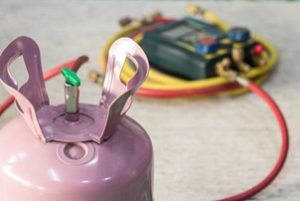NPO法人環境エネルギーネットワーク21主任研究員 石橋直彦
今年、人口が世界一になったインドは、経済の発展に伴い国民の購買力も比例的に増加して家電製品、例えばエアコンの生産量も増加していくと考えられる。現在ほとんどの家庭用エアコンにはフロン冷媒が使われており、エアコンの消費の伸びとともにフロン冷媒の使用量も増大することは容易に推測される。日本、米国及び欧州における冷媒の情報は多くあるが、インドにおける冷媒管理に関する情報はあまり目にすることがなかった。
筆者はJARN誌のウェブ版情報サイトeJARNからインドにおける冷媒管理に関する情報を得たので、以下に紹介する。
2023年5月、The Council on Energy, Environment and Water(CEEW)[エネルギー・環境・水協議会]はインドにおける冷媒の回収、再生、再使用及び破壊の実態についての研究を発表した。
ここ数年インドの冷媒生産は伸びており、2018年の24,300トンから2028年には75,000トンに達すると見込まれている。他国と比較すると、HFC冷媒生産世界一の中国の生産能力は、2020年にR134aを238,000トン超、R32を272,000トン、R125を106,000トンである。インドでは、HCFC冷媒及び高GWPのHFC冷媒の需要は25%~30%減少すると見込まれている。これはIndia Cooling Action Plan(ICAP)及びHCFC段階的廃止管理計画に因るものである。
A.Garg氏、S. Kumar氏及びS. Bhasin氏は、インドにおける冷媒の回収、再生、再使用及び破壊の全体的状況の実態を研究した(2023年)。ここ数年でインドはいくつかの冷媒管理計画を立ち上げて冷媒排出を抑えてきた。例えば、National CFC Consumption Phasing-out Plan (NCCoPP)[CFC消費の段階的廃止国家計画]は、家庭用エアコンサービス企業、とりわけ年間50 kg超のCFCを使う企業に対して優良なサービス実務を奨励するために、インドの15の州においてトレーニング基盤を設立した。
インドの冷媒の需要の約40 %はサービス分野に由来する。実際、粗末な設置や貧弱なサービス能力によって冷媒漏れは起きる。その結果として、NCCoPP戦略はサービス技能者のトレーニングを軸として展開した。参加者は代替冷媒の取扱い方法、優良なサービス方法、及びCFCの回収、リサイクル、再生及び再使用についての訓練を受けた。優良なサービス技術のトレーニングの結果としてCFCの需要は著しく減少した。これらトレーニングプログラムは、回収、再生冷媒の市場の創生に役立ち、また、メンテナンスに必要な再充塡はCFC再生、再利用に合致した。総計955のリサイクル装置がサービス企業やIndustrial Training Institutes (ITIs)[産業訓練機関]に国を通じて配られた。さらに、18か所の小規模再生センターが開かれ、移動式サービス機器によるCFC回収が開始され、回収されたCFCは再生施設に送られて再生された。
残念なことに、実際には、これらのプログラムはメーカーの方針、奨励制度の不足、流通上の難しさ、及び機能的なリバースサプライチェーン[a]を促進するための指導又は実施体制の欠如により、あまり効果的ではなかった。
報告書の執筆者は、回収・再生ツールが補助されたとしても小規模工務店やサービス技術者にとって冷媒管理は手軽でも採算性のあるものでもないと見ている。
冷媒管理や冷媒管理に対する障害や成し得る方策に関するより詳しい情報は、エネルギー・環境・水協議会(CEEW)のウエブサイト又はFRIDOCの研究を読んでいただきたい。
注[a] リバースサプライチェーンとは、原材料から製造業者による加工、卸売業者、流通業者、小売業者による流通を通して消費者に流れる製品の川上から川下への供給連鎖であるフォワードサプライチェーン(通称:サプライチェーン)の逆に、消費者が使用を終えた廃棄物の流れをいい、両者を併せて循環型サプライチェーンと呼ぶ。
------------------------------------------------------------------------------------------------------------------------------
India: the challenges of life-cycle refrigerant management
2023-08-07
In May 2023, the CEEW published a study examining the current status of refrigerant recovery, recycling, reuse, and destruction in India. In recent years, India’s refrigerant production has grown, estimated to reach about 75,000 tonnes in 2028, up from 24,300 tonnes in 2018.[1, 2] In comparison, in 2020, the production capacities of China, the world’s largest producer of HFC refrigerants, was more than 238,000 tonnes for R134a, 272,000 tonnes for R32 and 106,000 tonnes for R125.[3] In India, demand for HCFCs and high-GWP HFC refrigerants is expected to decrease by 25–30 per cent, thanks to the India Cooling Action Plan (ICAP) and the accelerated HCFC phase-out management plan.[2, 3]
examining the current status of refrigerant recovery, recycling, reuse, and destruction in India. In recent years, India’s refrigerant production has grown, estimated to reach about 75,000 tonnes in 2028, up from 24,300 tonnes in 2018.[1, 2] In comparison, in 2020, the production capacities of China, the world’s largest producer of HFC refrigerants, was more than 238,000 tonnes for R134a, 272,000 tonnes for R32 and 106,000 tonnes for R125.[3] In India, demand for HCFCs and high-GWP HFC refrigerants is expected to decrease by 25–30 per cent, thanks to the India Cooling Action Plan (ICAP) and the accelerated HCFC phase-out management plan.[2, 3]
A.Garg, S. Kumar and S. Bhasin (2023) examined the current status of the refrigerant recovery, recycling, reuse, and destruction ecosystem in India.[1] Over the years, India has initiated several refrigerant management projects to limit refrigerant emissions. For instance, the National CFC Consumption Phasing-out Plan (NCCoPP) created training infrastructure in 15 Indian states in order to promote good servicing practices in residential air conditioning servicing enterprises, especially in firms that used over 50 kg of CFCs per year.
About 40% of India’s refrigerant demand comes from the servicing sector. Indeed, due to poor installation and servicing practices, leakages occur. Consequently, the NCCoPP strategy was centred around the training of servicing technicians. The participants were trained on how to handle alternative refrigerants, excellent service methods, and the recovery, recycling, reclamation, and reuse of CFCs. As a result of training in good service techniques, CFC requirements were significantly reduced. These training programmes aided in the creation of a market for recovered and reclaimed refrigerants, and the refilling need for maintenance was met by CFC reclamation and reuse. A total of 955 recovery and recycling units were distributed to servicing enterprises and Industrial Training Institutes (ITIs) across the country. In addition, India opened 18 mini-reclamation centres and mobile service units were started to collect CFCs and deliver them to facilities for reclamation.
Unfortunately, in practice, these programmes were not very effective due to the lack of manufacturer initiative, incentive schemes, to logistical difficulties, and the absence of directives or implementation mechanisms to promote a functional reverse supply chain. The authors of the report observed that unless the recovery and recycling tools are subsidised, refrigerant management is neither affordable nor economically feasible for small workshops and servicing technicians.
For more details on barriers and possible measures to alleviate barriers to refrigerant management, read the complete study on the Council on Energy, Environment and Water (CEEW) website or on FRIDOC.
Sources
[1] Garg Aditya, Sonal Kumar, and Shikha Bhasin. 2023. Activating Circular Economy for Sustainable Cooling: Current Status and Barriers to Lifecycle Refrigerant Management in India. New Delhi: Council on Energy, Environment and Water. https://www.ceew.in/publications/status-barriers-in-refrigerant-management-activating-circular-economy-for-sustainable-cooling
[2] India Cooling Action Plan (ICAP). https://iifiir.org/en/fridoc/india-cooling-action-plan-icap-146725
[3] Yang et al 2022. ICCT. Measures for Reducing Greenhouse Gas Emissions from Motor Air Conditioning in China. https://theicct.org/publication/mac-ghg-china-lvs-feb22/
[4] https://iifiir.org